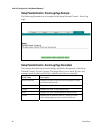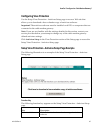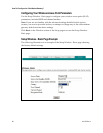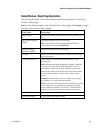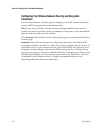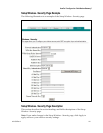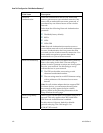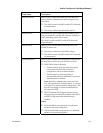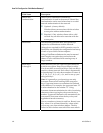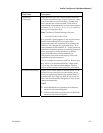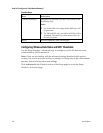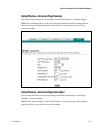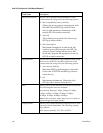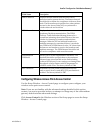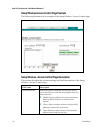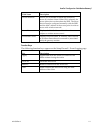
104 4011533 Rev A
How Do I Configure the Cable Modem Gateway?
Field Name Description
Shared Key
Authentication
Allows you to determine is Shared Key
Authentication is used in the network. Shared Key
Authentication can be used when there is no other
network authentication in the network.
Optional - (factory default)
Wireless clients can associate with the wireless
access point without authentication.
Required - Only wireless clients with a valid
network key are allowed to associate with the
access point.
PassPhrase Automatically generates WEP encryption keys
required to communicate with the network.
Although not required for WEP operation, use of a
PassPhrase can simplify the configuration and setup
of each of your client wireless adapters.
Using a PassPhrase eliminates the need to manual
enter lengthy encryption keys and reduces the
chance of error associated with entering entry of
large numbers.
64 Bit Keys
1 through 4
Select these keys for use with Encryption Mode set
to 64-bit encryption. Enter 5-byte values for a Key.
You do not have to set all four Keys. Only one Key is
used for a home network. Each value is represented
in hexadecimal. Use only these numbers or letters: 0,
1, 2, 3, 4, 5, 6, 7, 8, 9, a, b, c, d, e, and f to set up your
encryption keys.
Note: It is generally a good practice to use only
lowercase letters when entering WEP encryption
keys. Uppercase letters can sometimes be confused
with numbers. For example, the uppercase letter “B”
is often mistaken for the number “8.” Using
lowercase characters minimizes the risk of confusing
characters when copying keys from one device to
another. Uppercase characters will automatically be
converted to lowercase when the key or keys are
applied and saved to memory.
Use two numbers or letters in each box. Record your
Key values. You will need these Key values when
you set up your client wireless adapter. The Key
values in each wireless network device must match.



